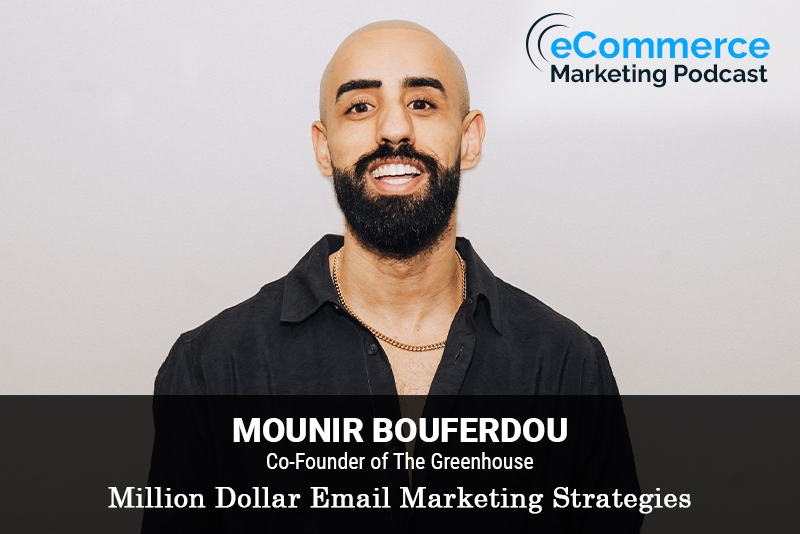
The eCommerce Marketing Podcast walks you through everything that goes into ecommerce marketing — from inbound marketing to paid advertising to conversions. Learn the strategies top marketing experts use to grow their businesses.
Mounir Bouferdou has gone from an international student to a retired semi-pro soccer player and former civil engineer solving real-life architectural problems to an entrepreneur co-founder of The Greenhouse solving eCommerce brands’ digital marketing problems. Before The Greenhouse, Mounir Co-founded 2 eCommerce brands that failed; the third time’s a charm co-founding The Greenhouse while in my last year of college. Over the last 2 years, we had the opportunity to work with more than 30 eCommerce brands on their email and SMS marketing and helped generate about @20M in sales.
In this episode, you will learn
What are the key elements of a high-converting email campaign that can drive significant revenue growth
How important is segmentation in an email marketing strategy, and what are some effective ways to segment customers to maximize revenue potential
Top strategies for scaling an eCommerce brand’s email revenue from $100,000 to $1 million
How crucial is it to maintain a healthy email list, and what are some best practices for list management and hygiene
Examples of a brands that have successfully grew their email revenue from $100,000 to $1 million
For show transcript and past guests, please visit https://www.ecommercemarketingpodcast.com
Or on YouTube at:
https://www.youtube.com/channel/UC3PgT0NOGzpdPGQtBK0XLIQ
Follow Arlen:
Twitter: https://twitter.com/askarlen
Facebook: https://www.facebook.com/arlen.robinson.7
Instagram: https://www.instagram.com/arlenyohance/
LinkedIn: https://www.linkedin.com/in/arlenrobinson/
Past guests on the ecommerce marketing podcast include Neil Patel, Nemo Chu, Luke Lintz, Luke Carthy, Amber Armstrong, Kris Ruby and many more.
Thanks for listening. Be sure to subscribe and leave a review.

Title: Explosive Growth with Email Marketing – with Mounir Bouferdou
Guest: Mounir Bouferdou, Co-Founder of The Greenhouse
Host: Arlen Robinson
Summary: In this episode of the eCommerce Marketing Podcast, Arlen Robinson speaks with Mounir Bouferdou, the co-founder of The Greenhouse. Mounir shares his journey from being an international student and civil engineer to becoming a successful entrepreneur. He discusses the pivotal role email marketing played in the growth of his own ventures and how The Greenhouse helps eCommerce brands achieve explosive growth through strategic email and SMS marketing.
Key Takeaways:
- [00:02:21] The Power of Email Marketing:
- Email marketing remains a powerful tool, contributing significantly to revenue growth. It provides control over customer touchpoints and helps build trust and loyalty.
- [00:06:44] Key Elements of High-Converting Email Campaigns:
- Focus on subject lines, content, and call-to-action. Personalize subject lines, create valuable and engaging content, and use clear and enticing CTAs to drive conversions.
- [00:09:10] The Importance of Testing:
- Continuously test different elements of email campaigns, including subject lines, content formats, and CTAs, to determine what resonates best with your audience.
- [00:15:08] Effective Email Segmentation:
- Segmenting email lists based on customer behavior, demographics, and engagement levels is crucial for personalized marketing and maximizing revenue.
- [00:20:00] Managing Dead Weight in Email Lists:
- Use separate email marketing lines to re-engage inactive subscribers with different strategies and content formats.
- [00:25:19] Scaling Up Email Marketing Efforts:
- Focus on consistent list growth, upselling and cross-selling, and implementing loyalty and referral programs to drive continued revenue growth.
- [00:31:02] Case Study:
- Mounir shares a case study of a client who scaled their email revenue from $50K to $150K per month by updating their email automations, increasing sending cadence, and optimizing their overall email marketing strategy.
Guest Info:
- Mounir Bouferdou
- Co-Founder of The Greenhouse
- LinkedIn: Mounir Bouferdou
- Email: [email protected]
- Instagram: mounirrrrrrr











